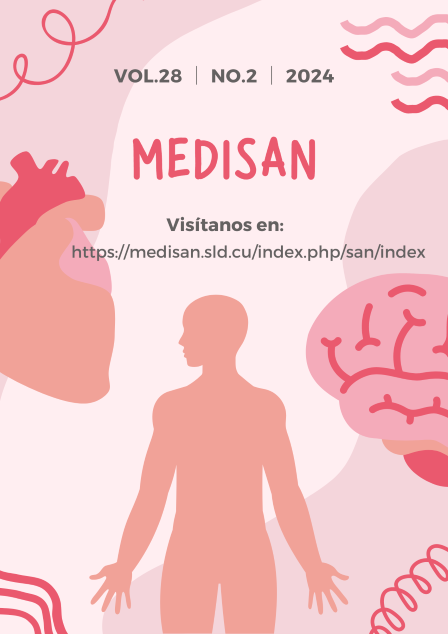Clinical epidemiological aspects of adults with anterior guide of dysfunctional dental occlusion
Keywords:
adult, dysfunctional dental occlusion, temporomandibular disorder, temporomandibular joint, bruxism, anterior guide of the occlusion.Abstract
Introduction: Anterior teeth have a predominant function in the stomatognatic system, essential for the aesthetics, phonation and mastication.
Objective: To characterize adults with anterior guide of dysfunctional dental occlusion according to clinical and epidemiological variables.
Methods: A descriptive and cross-sectional study, was carried out from October, 2021 to April, 2022, in the 3 de Octubre Teaching Stomatological Clinic from Las Tunas. The universe was formed by 825 medical records that contained the diagnosis of patients with bruxism, traumatic occlusion and temporomandibular disorders who presented anterior guide of the dysfunctional dental occlusion. By means of the intentional non probabilistic sampling, a sample of 615 with entire dental formula or class III partial toothlessness of Kennedy and concluded stomatologic care or inactivation of the cavity and acute inflammatory processes was selected.
Results: There was a prevalence of the female sex (54.8%) and the 40-49 age group (33.5%). Bruxism prevailed as clinical diagnosis (41.9%) with prevalence of the corresponding to sleep (39.1%), secondary (51.2%), probable (59.7%) and moderate (69.4%); among the most outstanding classifications was the dysfunctional stomatognatic system (84.4%). The predominant dental clinical manifestations were the wear facets (87.5%).
Conclusions: The characterization of patients with anterior guide of the dysfunctional dental occlusion allows to establish an up-to-date panoramic of this health problem, for a better follow-up and treatment to these patients.Downloads
References
2. Vedia Michel SA. Restablecimiento de la oclusión dental con resinas compuestas. Orbis Tertius UPAL. 2022 [citado 12/01/2023];6(11):125-39. Disponible en: https://biblioteca.upal.edu.bo/htdocs/ojs/index.php/orbis/article/view/117/204
3. Cárdenas Erosa R, Mendiburu Zavala CE, Cortes Carrillo D, Navarro Zapata D, Lugo Ancona P. Guía Anterior como factor etiológico del dolor de la articulación temporomandibular. IntraMed J. 2012 [citado 12/01/2023];1(3):1-6. Disponible en: https://www.intramed.net/contenidover.asp?contenidoid=80237
4. Okeson JP. Tratamiento de oclusión y afecciones temporomandibulares. 8 ed. España: Elsevier; 2019 [citado 12/01/2023]. Disponible en: https://www.edicionesjournal.com/catalogo/catalogo.pdf
5. Osorio Ayala LD, Paredes Tenesaca DP, Parra Calle MJ, Pesández Ibarra MJ, Yunca Picón MY, Barzallo Sardi V. Importancia de la guía anterior en el tratamiento de ortodoncia: Revisión de la literatura. Revista Latinoamericana de Ortodoncia y Odontopediatría. 2020 [citado 12/01/2023]. Disponible en: https://www.ortodoncia.ws/publicaciones/2020/art-61/
6. Organización Mundial de la salud. Salud bucodental. Ginebra: OMS; 2022 [citado 12/01/2023]. Disponible en: https://www.who.int/es/news-room/fact-sheets/detail/oral-health
7. Manfredini D, Ahlberg J, Wetselaar P, Svensson P, Lobbezoo F. The bruxism construct: From cut-off points to a continuum spectrum. J Oral Rehabil. 2019; 46(11):991-7.
8. Haro Espinosa DR. Relación entre la ausencia de guías funcionales y los trastornos temporomandibulares en estudiantes de la carrera de Odontología en la Universidad Nacional De Chimborazo [Tesis]. Perú: Universidad Nacional De Chimborazo; 2019.
9. Jorna Corrales L, Rodríguez González Y, Ureña Espinosa M. Caracterización de pacientes bruxópatas de un consultorio médico del municipio Las Tunas. Sinergia Académica. 2022 [citado 10/03/2023];5(1):1-11. Disponible en: http://www.sinergiaacademica.com/index.php/sa/article/view/68/525
10. Herrera López IB, Núñez Concepción YL. Bruxismo del sueño. Medimay. 2018 [citado 13/03/2023];25(2). Disponible en: https://revcmhabana.sld.cu/index.php/rcmh/article/view/1239/1564
11. Cardentey García J, González García X, Gil Figueroa BV, Piloto Gil B. Risk factors associated with bruxism in older adults in a health area. Rev. cienc. méd. Pinar Río. 2017 [citado 12/01/2023];21(5):669-76. Disponible en:
https://www.medigraphic.com/pdfs/pinar/rcm-2017/rcm175i.pdf
12. Noguera Planas MR, Molinet Mompié GI, Diz Suárez GC. Oclusión traumática y Bruxismo en la Disfunción Temporomandibular. Multimed (Bayamo). 2017 [citado 17/03/2023];19(6). Disponible en: https://revmultimed.sld.cu/index.php/mtm/article/view/431/689
13. Köstner Uribe S, Brunet Echavarría J, Tapia Vargas A. Trastornos de sueño asociados a bruxismo de sueño en niños entre 3 y 6 años de edad atendidos en la Clínica Odontológica de la Universidad Mayor de Santiago, Chile. Av Odontoestomatol. 2019 [citado 20/07/2023];35(2):83-91. Disponible en: http://scielo.isciii.es/scielo.php?script=sci_arttext&pid=S0213-12852019000200005&lng=es
14. Muñoz López D, Bugueño Valdebenito IM, Romo Ormazábal F, Garrido Urrutia C. Bruxismo secundario al consumo recreacional de éxtasis: Revisión de la Literatura. Int. J. Odontostomat. 2015 [citado 20/03/2023];9(2):213-8. Disponible en: http://www.scielo.cl/scielo.php?script=sci_arttext&pid=S0718-381X2015000200006&lng=es
15. Mendiburu Zavala CEPS, Naal Canto AA, Peñaloza Cuevas R, Carrillo Mendiburu J. Probable bruxismo y calidad de vida relacionada con la salud oral. Odovtos. 2022 [citado 12/01/2023];24(2):164-75. Disponible en: https://www.scielo.sa.cr/scielo.php?script=sci_arttext&pid=S2215-34112022000200164
16. Von Bischhoffshausen-p K, Wallem-H A, Allendes- A A, Díaz-M R. Prevalencia de bruxismo y estrés en estudiantes de Odontología de la Pontificia Universidad Católica de Chile. Int. J. Odontostomat. 2019 [citado 20/03/2023];13(1):97-102. Disponible en: https://www.scielo.cl/scielo.php?script=sci_arttext&pid=S0718-381X2019000100097&lng=es
17. Torres Cárdenas YJ, Chávez Reátegui BC, Manrique Chávez JE. Características clínicas periodontales de piezas con diagnóstico de trauma de oclusión secundario. Rev Estomatol Herediana. 2016 [citado 12/01/2023];26(1):13-9. Disponible en: https://revistas.upch.edu.pe/index.php/REH/article/view/2816/2677
18. Hernández Reyes B, Lazo Nodarse R, Bravo Cano O, Quiroz Aliuja Y, Domenech La Rosa L, Rodríguez Ramos S. Trastornos temporomandibulares en el sistema estomatognático del paciente adulto mayor. AMC. 2020 [citado 20/07/2023];24(4):e7426. Disponible en: http://scielo.sld.cu/scielo.php?script=sci_arttext&pid=S1025-02552020000400003&lng=es
19. Hernández Reyes B, Lazo Nodarse R, Díaz Gómez SM, Hidalgo Hidalgo S, Rodríguez Ramos S, Bravo Cano O. Bruxismo y manifestaciones clínicas en el sistema estomatognático. AMC. 2019 [citado 22/03/2023];23(3):309-18. Disponible en: http://scielo.sld.cu/scielo.php?script=sci_arttext&pid=S1025-02552019000300309&lng=es
20. San Juan Ortiz A, Nápoles Rodríguez NC. Efectividad de la fisioterapia como tratamiento coadyuvante del bruxismo. Opuntia Brava. 2022 [citado 17/07/2023];14(2):224-36. Disponible en: https://opuntiabrava.ult.edu.cu/index.php/opuntiabrava/article/view/1579/1786
Published
How to Cite
Issue
Section
License
All the articles can be downloaded or read for free. The journal does not charge any amount of money to the authors for the reception, edition or the publication of the articles, making the whole process completely free. Medisan has no embargo period and it is published under the license of Creative Commons, International Non Commercial Recognition 4.0, which authorizes the copy, reproduction and the total or partial distribution of the articles in any format or platform, with the conditions of citing the source of information and not to be used for profitable purposes.





